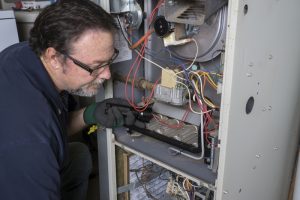 Generally speaking, gas furnaces are not inherently dangerous. This is an important fact to clear up right away—we don’t want you to feel panic just because you use a furnace for your home heating. Like any other powerful appliance that creates combustion gases, however, a furnace can potentially create health hazards if not maintained regularly and if Puyallup, WA furnace repairs are taken care of right away. If you stay on top of these repairs, you’ll have few worries.
Generally speaking, gas furnaces are not inherently dangerous. This is an important fact to clear up right away—we don’t want you to feel panic just because you use a furnace for your home heating. Like any other powerful appliance that creates combustion gases, however, a furnace can potentially create health hazards if not maintained regularly and if Puyallup, WA furnace repairs are taken care of right away. If you stay on top of these repairs, you’ll have few worries.
So when can neglecting repairs actually be dangerous? When you ignore the need to fix cracked heat exchangers. This is most likely to happen with an older furnace—we’re talking about 15+ years. This is why we recommend looking into a replacement as soon as you know a furnace is approaching the end of its lifespan. It’s also why we strongly recommend staying on top of your annual maintenance appointments. Tune-ups will help you catch any furnace problems early so you can arrange for repairs or a replacement right away without risking your safety by neglecting repair needs.
More About Heat Exchangers
A heat exchanger is a vital part of a natural gas-powered furnace. This is where the heat from the combustion gas transfers to the air from the blower fan that moves into the ventilation system. The combustion gas can’t come into direct contact with the air, or else unhealthy fumes would end up going into the living spaces (we’re talking about carbon monoxide exposure, here).
Instead, the combustion gas enters the heat exchanger, which is a metal clam-shaped chamber within the system. The heat of the combustion gas raises the temperature of the metal, and as the air from the blower passes through it, heat transfers to it. Essentially, the heat exchanger is where the furnace actually heats the air.
The Problem with a Cracked Heat Exchanger
A cracked heat exchanger enables exhaust fumes inside the exchanger to leak into the air. The most toxic of these exhaust fumes is carbon monoxide, which can cause severe health problems. The furnace typically sends the fumes out a flue. However, a crack can allow some to seep out.
How do these cracks occur? Most often, it’s due to corrosion. The reaction between the combustion gas and metal over time can cause the metal to weaken—which is why we say you’re most likely to experience this problem in an older furnace. Even the smallest crack can be an issue, since eventually it will stretch wider as the heat exchanger turns hot and expands.
How Do I Know if I Have a Cracked Heat Exchanger?
As we mentioned, maintenance is the best way to ensure that you don’t have a problem with your furnace. But what if you haven’t had a tune-up in a while, or you’re just concerned about the condition of the heater? One thing you can watch for—or rather, listen for—is a clicking sound coming from the furnace after the blower shuts off. Another clear sign that something is amiss is that one or more of your carbon monoxide detectors goes off, in which case you should shut off your gas supply right away and call in the pros to help.
Contact Sound Heating and Air Conditioning Inc. today! We take your comfort as serious as you do.
